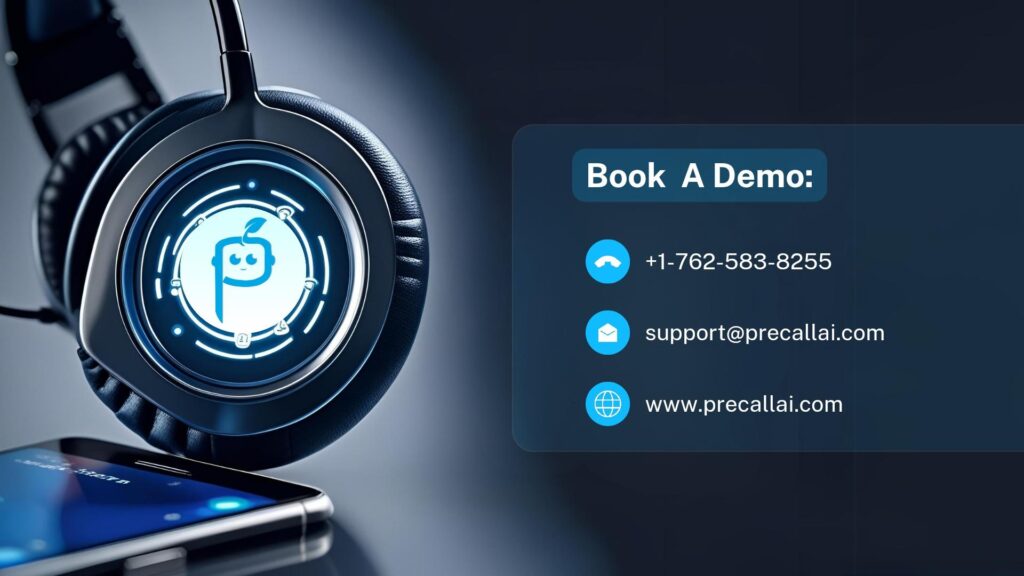Introduction
Businesses are constantly seeking innovative solutions to improve customer interactions. AI voice bots are intelligent systems that can automate phone conversations, streamline customer service, and improve overall efficiency. However, with many options available, selecting the right AI voice bot for your company can be a difficult task.
In this blog, we will explore key factors to consider when choosing the perfect AI voice bot to meet your business needs.
Table of Contents
What is an AI Voice Bot?
An AI voice bot is an automated software application that uses artificial intelligence to resemble human conversation. These bots can handle various tasks, including answering customer inquiries, providing information, and even completing transactions. By leveraging natural language processing (NLP) and machine learning, AI voice bots can understand and respond to customer requests in real-time.
Features of AI Voice Bot
1. 24/7 Availability:
AI voice bots offer the great benefit of being available around the clock. This 24/7 availability means that customers can receive assistance at any time of day or night, regardless of time zones or business hours. Customers appreciate the ability to get support whenever they need it, which they need it, which can lead to higher satisfaction levels. With an AI voice bot handling inquiries, customers experience significantly reduced wait times, as they do not have to wait for a human agent to become available.
2. Cost Efficiency:
Using an AI voice bot might result in major savings for companies. Businesses can use fewer human agents to handle repetitive questions and tasks. Human agents may focus on advanced and valuable jobs that need empathy, problem-solving solving and reasoning. AI voice bots may operate at a lower cost tha human agents, especially during peak hours when call volumes are high. Flexibility allows businesses to manage their operating expenses better.
3. Flexibility:
AI voice bots are naturally flexible, making them an ideal solution for businesses experiencing growth or fluctuations in demand. During peak periods, such as holidays or promotional events, AI voice bots can handle a large number of calls at the same time. This capability ensures no customer is left waiting, which is crucial for maintaining customer satisfaction during busy times. As your business grows, you can easily expand the AI voice bot’s capabilities without requiring extensive retraining or additional hires. They provide the same level of service to every customer, which makes sure that quality does not diminish during high-demand periods.
4. Increased Customer Experience:
AI voice bots improve the overall client experience by providing quick, accurate, and personalized responses. Customers no longer have to navigate long wait times or be placed on hold. AI voice bots can quickly process requests and provide immediate answers, which increases customer satisfaction. AI voice bots are programmed to provide accurate information based on customer behavior or preferences, proactively addressing potential issues or offering assistance before the customer even asks.
Tips to Choose The Right AI Voice Bot
1. Understand your Business Needs First –
Before diving into features, think about why you need an AI voice bot. You just have to ask yourself:
- Are you missing important client calls?
- Is your support team overwhelmed with repetitive queries?
- Do you want to automate outbound calls for sales or follow-ups?
- Are you aiming to reduce response time or increase customer satisfaction?
Identifying your main pain points will help you focus on what truly matters. For instance, a real estate agency may want quick lead qualification, while an e-commerce brand may need 24/7 order support. Your bot should serve your specific goals, not just sound impressive on a demo call.
2. Decide Between Inbound or Outbound (or Both) –
Voice bots generally fall into two categories: inbound (handling incoming calls) and outbound (making calls to customers or leads).
- Inbound AI bots are great for customer service, handling queries, appointment booking, and support tickets.
- Outbound AI bots are ideal for follow-ups, reminders, sales outreach, feedback collection, or order confirmations.
Some platforms, like PreCallAI, handle both smoothly. Think about your communication flow and whether you need the bot to answer, dial, or do a bit of both.
3. Prioritize Natural, Human-Like Conversations –
One of the biggest reasons people still hesitate to use bots is that they sound robotic or confusing. When testing different platforms, pay attention to:
- How natural the voice sounds
- How well it handles different accents
- Whether it pauses at the right times
- How it handles interruptions or questions
A truly good AI voice bot should feel like you are talking to a human who just happens to be lightning fast and never takes a break. Try demo calls, and do not settle for clunky or robotic voices.
4. Look for Industry-Focused Use Cases –
Not every voice bot works well across every industry. Look for companies that offer solutions tailored to your business type. For example:
- Healthcare: Appointment reminders, patient info, insurance verification
- Real Estate: Lead qualification, property booking, follow-up calls
- E-commerce: Order updates, returns, FAQs, and delivery confirmations
- Insurance: Claim status, policy info, new lead calls
- Education: Admission queries, course registration, alerts
Platforms like PreCallAI offer ready-to-use call flows built for specific industries, saving you weeks of setup time.
5. Check Integration Capabilities –
Your AI voice bot should not be a standalone tool. It should work smoothly with your CRM, helpdesk, calendar, or sales platforms. Before buying:
- Ask what platforms the bot can integrate with
- Check if it connects easily with tools like Salesforce, HubSpot, Zoho, or GoHighLevel
- See if it allows custom APIs or webhooks for special needs
The more connected your bot is, the more powerful and valuable it becomes. For example, PreCallAI integrates with multiple platforms, allowing real-time sync of calls, leads, and customer data.
6. Review the Setup Process –
A great product that’s hard to set up is not so great after all. Look for solutions that offer:
- Easy onboarding
- No-code or low-code interface
- Pre-built conversation templates
- Helpful customer support
You don’t want to hire a developer every time you want to change your call script. The right platform should let you make changes with just a few clicks.
7. Analyze Reporting & Insights –
Your AI voice bot should not only talk to customers, but it should also give you smart insights.
Look for features like:
- Call completion rate
- Missed or dropped calls
- Sentiment analysis
- Lead qualification rates
- Call transcripts and summaries
These data points help you improve customer service, understand what’s working, and even find new business opportunities.
8. Think About Language and Regional Support –
If your business serves customers in different regions or languages, make sure your bot supports them and ask the following queries:
- Can it handle local dialects or multilingual conversations?
- Does it pronounce names and locations correctly?
- Is it trained for regional business terms?
Language flexibility ensures that no customer feels left out, especially if you’re scaling globally or serving diverse communities.
9. Consider 24/7 Availability –
One of the best things about using an AI voice bot is that it never takes a break. But make sure the bot:
- Has high uptime
- Can handle call spikes
- Works around the clock
If you receive a lot of customer queries after hours or during weekends, a 24/7 voice bot is a game-changer. It ensures that every caller gets attention anytime they call.
10. Ask for Real-Life Success Stories –
Do not just take their word for it. Ask vendors for:
- Case studies
- Video testimonials
- Call demos
- Client success metrics
Companies like PreCallAI showcase how businesses across real estate, insurance, SaaS, and e-commerce use their bots to boost conversions and save hours every day.
11. Compare Pricing with ROI –
It is tempting to choose the cheapest option, but the real question is, what do you get for your money? Evaluate:
- What’s included in the plan
- Whether there are hidden costs (like call minutes, integrations, or support)
- How much time or staffing cost does it save you monthly
- Whether it leads to more sales or better customer retention
A good AI voice bot should pay for itself quickly. The right one won’t feel like a cost, it will feel like an investment.
12. Evaluate Customer Support –
At some point, you will need help, maybe to fine-tune a script or understand a report. That is when strong customer support matters and check if:
- They offer live chat or phone support
- You get a dedicated account manager
- There’s a helpful knowledge base or learning hub
- Onboarding is guided, not DIY
With platforms like PreCallAI, you will find real people ready to support you, especially helpful for first-time users.
Are AI Voice Bots Right for Small Businesses?
They are beneficial, especially the ones that do not require code. Small businesses often receive the same calls: appointment requests, follow-ups, order status, and FAQs.
AI speech bots manage these discussions well, and doing so with software reduces missed calls, voicemails that go ignored, and the need to hire extra employees just to remain on top of the phone.
Which Businesses Get the Most Out of Using Voice Bots?
If your team handles the same types of phone calls over and over, a voice bot can really help, especially when speed, volume, or clear communication are important.
These are some of the areas where voice bots are making the biggest difference:
- Call Centers:
Voice bots are increasingly being used by inbound support teams to handle FAQs, triage requests, and route to the right human when necessary. Outbound calls are used to confirm appointments, give reminders, and manage follow-ups.
When connected with the appropriate CRM or helpdesk, a voice bot for contact centers can free up people to focus on complicated issues, cut average handle times, and ensure that conversations are always logged.
- Sales and Lead Qualification:
Voice bots can make initial outreach calls, ask qualifying questions, and direct leads to the appropriate representative. If properly integrated, they can also handle missed phone follow-ups and automatically re-engage inactive leads.
In B2B sales, this is especially valuable for SDR teams dealing with high call volumes.
- Recruiting and Hiring:
Instead of a recruiter calling each candidate to ask the same screening questions, a voice bot can manage the front-line engagement by gathering basic information, verifying qualifications, and passing notes.
- Healthcare:
Voice bots allow clinics and provider networks to automate routine tasks such as appointment booking, prescription refills, and test result updates while following privacy and compliance guidelines.
Some even offer multilingual interactions, which increases accessibility across areas.
- E-commerce and Logistics:
Order status, delivery delays, and return confirmations are all normal phone contacts that a voice bot can handle for your support team. When connected to your order system or ERP, it can provide exact replies based on real-time data.
These bots benefit these websites. However, do they suit small businesses? That is what we will answer next.
Also Read: Best AI Voice Changer For Incoming Voice Calls
Conclusion

Choosing the right AI voice bot for your company is more than just checking off features. It’s about finding a partner that understands your goals, helps you connect with customers better, and gives your team more time to do what matters most. From smarter lead follow-ups to better support and 24/7 availability, the right bot can change the way you work.






[…] voice bot implementation best practices require careful planning and execution. Best practices guide businesses through complex deployment […]